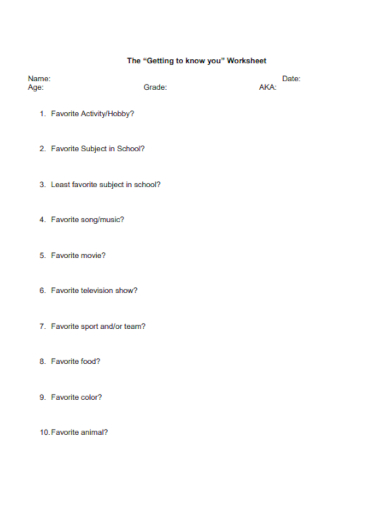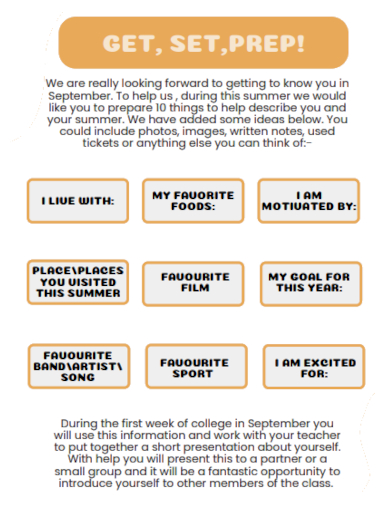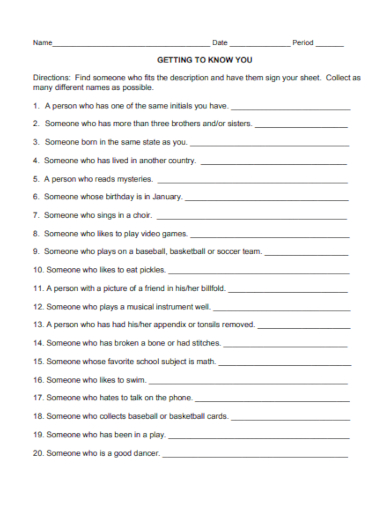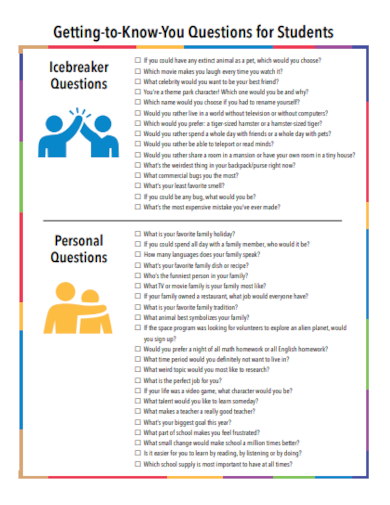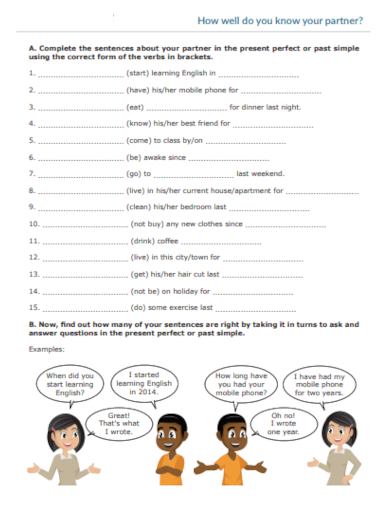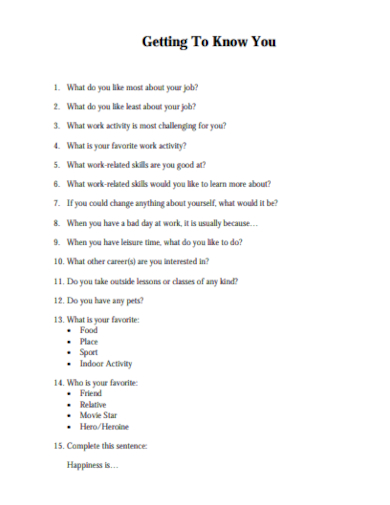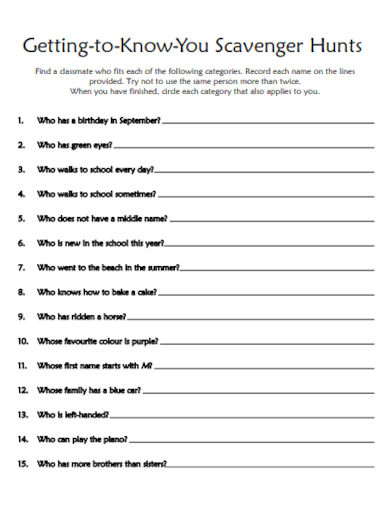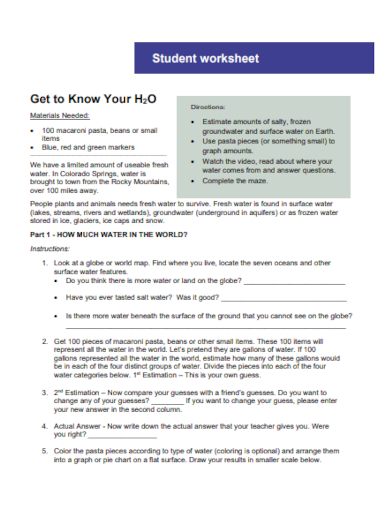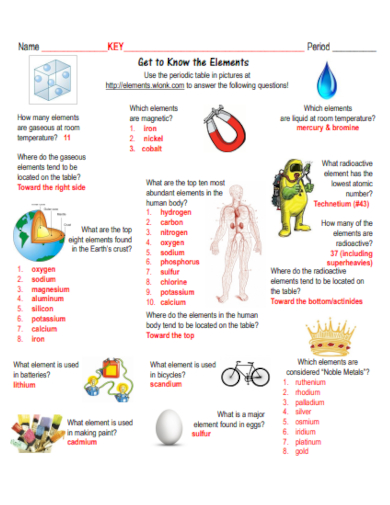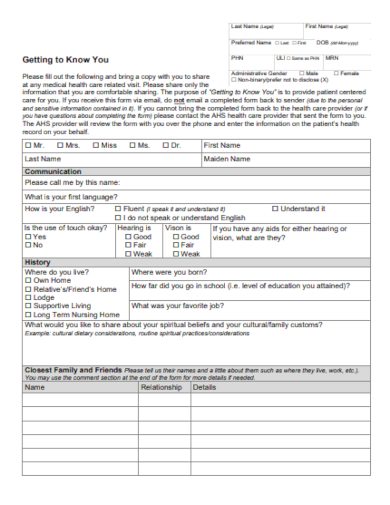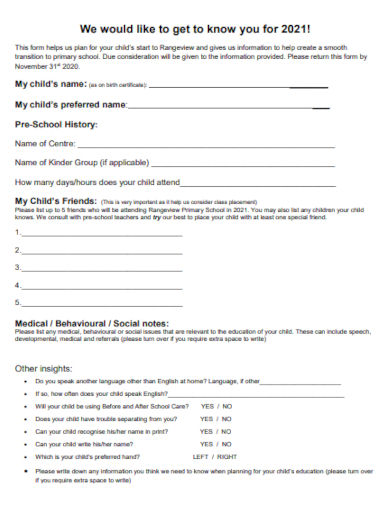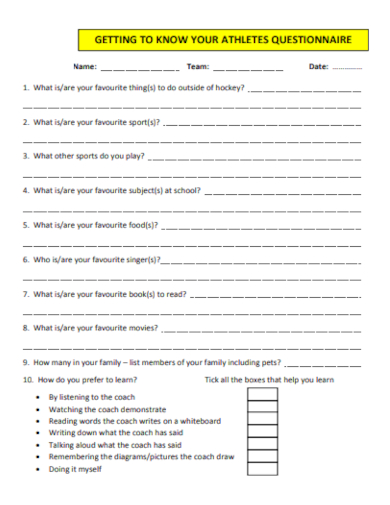Dive into the realm of self-discovery with our Sample Get To Know You Worksheet Template. Crafted meticulously for those eager to unearth their unique facets, this worksheet serves as a bridge to deeper self-awareness and connection with others. Whether you’re a teacher, mentor, or simply on a personal growth journey, harness the power of introspective questions and ignite meaningful conversations. Embrace the quest to understand and be understood – your transformative journey begins here.
12+ Get To Know You Worksheet Samples
1. Get To Know You Worksheet Template
2. Printable Get To Know You Worksheet
3. Get To Know You Worksheet for Students
4. Professional Get To Know You Worksheet
5. Get To Know You Questions Worksheet
Get to Know the Teacher Game: An Engaging Introduction
The Get to Know the Teacher game is a playful and interactive way to introduce a teacher to their students, particularly at the beginning of a school year or term. This game can help in breaking the ice and fostering a warm classroom environment where students feel more connected to their instructor. While the primary audience for this activity is often younger students, variations can make it effective for older age groups as well.
The Basic Concept
At its core, the “Get to Know the Teacher” game revolves around sharing personal facts, stories, or quirks about the teacher that students must guess or infer. These can range from favorite hobbies, past experiences, favorite books, or even funny anecdotes from their past.
How to Play:
Preparation: The teacher prepares a set of statements or facts about themselves. Some of these can be true, while others are made up or exaggerated.
Presentation: The teacher then shares these statements with the students, either verbally, on a slide show, or through printed cards.
Guessing Time: Students then have to guess which statements are true and which are false. This can be done individually, in pairs, or in groups.
Reveal & Share: After the students have made their guesses, the teacher reveals the correct answers and can elaborate on each fact or story, making it an engaging storytelling session.
Benefits of the Game:
Building Connections: This game provides an opportunity for students to see their teacher in a new light, not just as an authority figure, but as someone with a life outside of school, with interests, experiences, and a sense of humor.
Encouraging Participation: Especially for students who might be shy or hesitant to participate in class discussions, this can be a non-threatening way to get them engaged and talking.
Setting a Positive Tone: Starting the term with a fun and light-hearted activity can set a positive tone for the rest of the academic period. It signals to students that while learning is a priority, the classroom is also a place for positive interactions and fun.
Modeling Behavior: By sharing about themselves, teachers are modeling the behavior they wish to see from students: openness, vulnerability, and the courage to share personal details in a public setting.
Variations & Tips:
Student Version: After the teacher’s turn, students can have the chance to play the game too, sharing facts about themselves which can further enhance class bonding.
Props & Pictures: Teachers can bring in props or show pictures related to their facts/stories, making the game more visual and engaging.
Question Time: After the game, open the floor for students to ask questions. This not only allows them to satiate their curiosity but can also lead to more interesting discussions and stories.
Tailor to Age Group: For older students, teachers might choose to share more complex or thought-provoking facts or experiences, turning the game into not just a fun activity, but also a deep conversation starter.
The Get to Know the Teacher game is more than just a game. It’s an opportunity for connection, storytelling, and setting the groundwork for a positive and collaborative classroom environment. Whether you’re a teacher looking to build rapport with your students or simply seeking a fun way to kickstart the academic year, this game can be a valuable tool in your teaching arsenal.
6. Get To Know You Partner Worksheet
7. Get To Know Beginner Worksheet
8. Get To Know Information Worksheet
9. Get To Know You Interactive Worksheet
Creating a Worksheet Template: A Comprehensive Guide
Creating a worksheet template is an effective way to streamline tasks, ensure consistency, and provide an organized framework for various activities, be it in the classroom, workplace, or for personal use. A good worksheet template not only serves its purpose but is also user-friendly and aesthetically pleasing. Here’s a step-by-step guide to help you create one:
1. Define the Purpose:
Before diving into the design, clearly define what the worksheet will be used for. Is it for a math class, a survey, a business report, or a personal budget? Your purpose will guide your design choices and the type of content you’ll include.
2. Choose the Right Tool:
Depending on your needs and proficiency, there are several tools you can use:
Word Processors (e.g., Microsoft Word): Great for text-heavy worksheets or simple layouts.
Spreadsheets (e.g., Microsoft Excel, Google Sheets): Ideal for numerical data, budgets, or tasks that require calculations.
Design Software (e.g., Adobe InDesign, Canva): Suitable for more graphic-intensive or aesthetically driven worksheets.
3. Plan the Layout:
Margins & Spacing: Ensure your content isn’t too cramped. Adequate spacing makes the worksheet more readable and user-friendly.
Grids & Tables: Use these for organized data presentation. They help in aligning content neatly.
Sections: Clearly define different sections using headings or different background colors for clarity.
4. Design Aesthetics:
Font Choice: Use legible fonts. It’s best to stick with 1 or 2 complementary fonts – one for headings and another for content.
Color Scheme: Choose a set of 2-4 complementary colors that aren’t too jarring. If it’s for a brand or specific organization, use their brand colors.
Graphics & Icons: Use relevant images, graphics, or icons to make the worksheet engaging. Ensure they are of high quality and do not clutter the space.
5. Incorporate Interactive Elements (If Needed):
If your worksheet will be used digitally, consider adding interactive elements like checkboxes, drop-down lists, or hyperlinks. Tools like Adobe Acrobat or Google Forms can help in creating interactive PDFs or online worksheets.
6. Make It User-Friendly:
Instructions: Clearly state any instructions at the beginning or in the relevant sections.
Example Entries: If applicable, provide example entries to guide the user on how to fill out the worksheet.
7. Test and Revise:
Before finalizing your template, test it out. If it’s for classroom use, maybe do a pilot run with a few students. If it’s for business, have a colleague review it. Gather feedback and make necessary revisions.
8. Save and Share:
Save as a Template: Once satisfied, save your worksheet as a template. This way, you won’t overwrite the original when creating new worksheets from it.
File Format: Consider saving in different formats depending on how it will be used, e.g., PDF for print or interactive use, Word/Excel for editable versions, etc.
9. Reuse and Update:
The beauty of a template is in its repeatability. As you use the worksheet, you may find areas to improve or update based on changing needs. Regularly revisit and refine your template to keep it relevant and effective.
In conclusion, creating a worksheet template is a balance of function and design. By investing time initially in crafting a well-thought-out template, you’ll save effort in the long run and ensure the users of the worksheet have a seamless experience. Whether for teaching, business, or personal use, a well-designed worksheet template is a powerful tool for organization and productivity.
10. Get To Know Activity Worksheet
11. Sample Get To Know You Worksheet
12. Get To Know You Worksheet in PDF
13. Get To Know You Questionnaire Worksheet
Exploring the Varied Landscape of “Get to Know Me” Templates
“Get to Know Me” templates are designed to foster connection, build rapport, and enhance understanding among individuals, whether in a personal, professional, or educational setting. Their adaptability and diverse applications make them invaluable tools. Let’s explore the different types of these templates and their specific contexts:
1. Classroom Introductions:
Student Profiles: These templates may include prompts about favorite books, hobbies, family, and summer memories. They’re commonly used at the beginning of the school year to help classmates and teachers learn about each student.
Teacher Introduction Boards: Teachers use these to share about their personal life, teaching philosophy, and fun facts, helping students see them as more approachable and human.
2. Professional Icebreakers:
Employee Onboarding Sheets: For new hires, these templates might involve questions about previous job roles, skills, aspirations, and a fun fact or two. They can ease the integration of new employees into teams.
Team Building Worksheets: Designed for workshops or team-building retreats, these sheets may feature prompts about personal strengths, challenges, or even quirky superpower wishes.
3. Social Media Templates:
Instagram Story Templates: With prompts like “This or That”, “My Top 5 Movies”, or “A Day in My Life”, these are visually engaging and allow followers a glimpse into the personal preferences and daily lives of users.
Blogger Introduction Posts: New bloggers or influencers might use templates to structure a post introducing themselves to their audience, sharing their backstory, passions, and what readers can expect from their content.
4. Dating & Relationship Building:
Dating Profile Templates: These guide individuals in presenting themselves on dating platforms, prompting details about hobbies, life goals, and relationship expectations.
Relationship Deepening Worksheets: For couples wishing to strengthen their bond, templates might include deeper questions about life philosophies, fears, dreams, and defining moments in life.
5. Personal Growth & Self-reflection:
Personal Journal Templates: Designed for individual introspection, these might include prompts like “What I love about myself”, “My proudest moments”, or “Challenges I’ve overcome”.
Life Milestones Worksheets: These help individuals document significant moments in their lives, from academic achievements to personal epiphanies, offering a holistic view of one’s journey.
6. Networking & Events:
Event Attendee Profiles: In conferences or workshops, attendees might fill these out to share their professional backgrounds, expectations from the event, and areas of interest, facilitating better networking.
Speaker Introduction Sheets: These allow event speakers to provide a brief about their expertise, topics they’ll cover, and perhaps a personal anecdote or two.
7. Therapeutic & Counseling Contexts:
Initial Consultation Sheets: Therapists and counselors might use templates to gather foundational information about a client’s background, challenges, and therapy goals.
Self-discovery Worksheets: Used in therapeutic settings, these delve deep with prompts about feelings, past traumas, aspirations, and personal growth areas.
In conclusion, “Get to Know Me” templates are versatile tools tailored to diverse contexts. They serve as catalysts for connection, offering structured ways to share, introspect, and bridge understanding among individuals. When crafted thoughtfully, these templates can elevate the experience of getting to know someone, whether it’s a student, colleague, follower, partner, or oneself.
Related Posts
FREE 20+ Goal Setting Worksheet Samples in MS Word | Google Docs | Pages | Excel | Google Sheets | Numbers | PPT | PDF
FREE 30+ Cost Worksheet Samples in Google Docs | Google Sheets | MS Excel | MS Word | Apple Numbers | Apple Pages | PDF
FREE 50+ Assessment Worksheet Samples in PDF | MS Word
FREE 25+ Campaign Worksheet Samples in PDF
FREE 50+ Application Worksheet Samples in PDF | MS Word
FREE 10+ Distribution Worksheet Samples in PDF
FREE 10+ Family Worksheet Samples in PDF
FREE 10+ Personal Worksheet Samples in PDF
FREE 7+ Depreciation Worksheet Samples & Templates in PDF | MS Word
FREE 10+ Typing Worksheets Samples in PDF | DOC
FREE 10+ Maths Worksheets Samples in PDF | DOC
FREE 10+ 4th grade Worksheets Samples in PDF
FREE 10+ Weekly Budget Worksheet Samples in MS Word | MS Excel | Google Docs | Google Sheets | PDF
FREE 10+ Expense Worksheet Samples in PDF
FREE 10+ Investment Worksheet Samples in PDF

